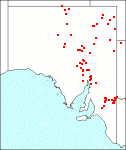Family: Amaryllidaceae
Crinum flaccidum
Citation:
Herbert, Curtis's Bot. Mag. 47:t. 2121 (1820).
Synonymy: Crinum luteolum, Crinum pedunculatum auct.non R.Br.: J.M.Black(1922) Common name: Darling lily, Murray lily, Sandover lily. (I11. Cunningham et al. (1982) Plants of western New South Wales, p. 191.)
Description:
Bulb ovoid, 7-10 cm diam.; leaves long, flat, 1-3 cm broad.
Scape stout, compressed, to 60 cm high, with 4-15 white rarely yellowish strongly scented flowers in the umbel; spathe-bracts papery, oblong, often unequal, broad at the base, 7-12 cm long; pedicels 1-4 cm long; perianth-tube 5-12 cm long, the lobes 5-7.5 cm long, 1.5-2 cm broad; filaments nearly as long as the lobes; anthers yellow, 1-1.5 cm long, often arched.
|
|
Distribution:
|
S.Aust.: LE, GT, FR, EA, EP, MU. All mainland States.
|
Conservation status:
native
Flowering time: Feb. — June.Fig. 805C.
|

SA Distribution Map based
on current data relating to
specimens held in the
State Herbarium of South Australia
|
Biology:
No text
Taxonomic notes:
C. luteolum H.P. Traub & L.S. Hann., Pl. Life 21:96 (1965). This name was published for a yellow form from the FR region. In 1966 the same authors (Pl. Life 22:46-47) published an amplified description and the following characters for distinguishing the 2 species they recognised: "In C. luteolum the leaves are evergreen, larger, and the entire leaf withers with maturity; in its native habitat it flowers usually in late winter to spring; the flowers are light primrose yellow with relatively heavier substance; the lower three stamens are shorter and grouped together, the upper three somewhat wider apart. There are other differences." There is no doubt that this form is very different from plants from some other areas, for example the Murray River. However, few of these characters can be determined from dried specimens and available data suggests that intermediate forms may make it unsatisfactory to distinguish these species. Plants which may show some characters of C. luteolum have been collected in the LE and GT regions.
Author:
Not yet available
|

